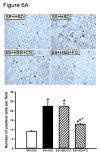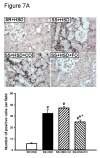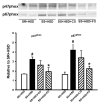Signaling pathways modulated by fish oil in salt-sensitive hypertension
- PMID: 18385269
- PMCID: PMC2879056
- DOI: 10.1152/ajprenal.00401.2007
Signaling pathways modulated by fish oil in salt-sensitive hypertension
Abstract
Although many studies have indicated that fish oil (FO) improves cardiovascular risk factors and reduces histopathological manifestations of injury in experimental renal injury models, potential mechanisms underlying this protective effect have not been adequately defined. The objective of this study was to identify potential signaling pathways that confer protection in the Dahl rat model of salt-sensitive hypertension. Male Dahl salt-sensitive rats (n = 10/group) were provided with formulated diets containing 8% NaCl, 20% protein, and 25% FO or 25% corn oil (CO) for 28 days. FO reduced blood pressure (-11% at 4 wk; P < 0.05), urine protein excretion (-45% at 4 wk; P < 0.05), plasma cholesterol and triglyceride levels (-54%, P < 0.001; and -58%, P < 0.05), and histopathological manifestations of renal injury, including vascular hypertrophy, segmental and global glomerular sclerosis, interstitial fibrosis, and tubular atrophy. Interstitial inflammation was significantly reduced by FO (-32%; P < 0.001), as assessed by quantitative analysis of ED1-positive cells in sections of the renal cortex. FO reduced tubulointerstitial proliferative activity, as assessed by Western blot analysis of cortical homogenates for PCNA (-51%; P < 0.01) and quantitative analysis of Mib-1-stained sections of the renal cortex (-42%; P < 0.001). Decreased proliferative activity was associated with reduced phospho-ERK expression (-37%; P < 0.005) and NF-kappaB activation (-42%; P < 0.05). FO reduced cyclooxygenase (COX)-2 expression (-63%; P < 0.01) and membrane translocation of the NADPH oxidase subunits p47(phox) and p67(phox) (-26 and -34%; P < 0.05). We propose that FO ameliorates renal injury in Dahl salt-sensitive rats through the inhibition of ERK, decreased NF-kappaB activation, inhibition of COX-2 expression, and decreased NADPH oxidase activation.
Figures
















Similar articles
-
Renal functional, not morphological, abnormalities account for salt sensitivity in Dahl rats.J Hypertens. 2009 Mar;27(3):587-98. doi: 10.1097/hjh.0b013e32831ffec7. J Hypertens. 2009. PMID: 19330919
-
Sodium bicarbonate loading limits tubular cast formation independent of glomerular injury and proteinuria in Dahl salt-sensitive rats.Clin Sci (Lond). 2018 Jun 20;132(11):1179-1197. doi: 10.1042/CS20171630. Print 2018 Jun 15. Clin Sci (Lond). 2018. PMID: 29650676 Free PMC article.
-
Effects of dietary salt on intrarenal angiotensin system, NAD(P)H oxidase, COX-2, MCP-1 and PAI-1 expressions and NF-kappaB activity in salt-sensitive and -resistant rat kidneys.Am J Nephrol. 2008;28(1):158-67. doi: 10.1159/000110021. Epub 2007 Oct 19. Am J Nephrol. 2008. PMID: 17951998
-
Glucose-independent renoprotective mechanisms of the tissue dipeptidyl peptidase-4 inhibitor, saxagliptin, in Dahl salt-sensitive hypertensive rats.Eur J Pharmacol. 2016 Jul 15;783:56-63. doi: 10.1016/j.ejphar.2016.04.005. Epub 2016 Apr 7. Eur J Pharmacol. 2016. PMID: 27063445
-
Antioxidative effect of p38 mitogen-activated protein kinase inhibitor in the kidney of hypertensive rat.J Hypertens. 2005 Jan;23(1):165-74. doi: 10.1097/00004872-200501000-00027. J Hypertens. 2005. PMID: 15643139
Cited by
-
Docosahexaenoic acid reverses angiotensin II-induced RECK suppression and cardiac fibroblast migration.Cell Signal. 2014 May;26(5):933-41. doi: 10.1016/j.cellsig.2014.01.005. Epub 2014 Jan 19. Cell Signal. 2014. PMID: 24447911 Free PMC article.
-
Dietary Docosahexaenoic Acid Reduces Oscillatory Wall Shear Stress, Atherosclerosis, and Hypertension, Most Likely Mediated via an IL-1-Mediated Mechanism.J Am Heart Assoc. 2018 Jun 30;7(13):e008757. doi: 10.1161/JAHA.118.008757. J Am Heart Assoc. 2018. PMID: 29960988 Free PMC article.
-
Association of Dietary Fish and n-3 Unsaturated Fatty Acid Consumption with Diabetic Nephropathy from a District Hospital in Northern Taiwan.Nutrients. 2022 May 21;14(10):2148. doi: 10.3390/nu14102148. Nutrients. 2022. PMID: 35631289 Free PMC article.
-
EPA-Enriched Phospholipids Alleviate Renal Interstitial Fibrosis in Spontaneously Hypertensive Rats by Regulating TGF-β Signaling Pathways.Mar Drugs. 2022 Feb 19;20(2):152. doi: 10.3390/md20020152. Mar Drugs. 2022. PMID: 35200681 Free PMC article.
-
Cyclooxygenase 2: protein-protein interactions and posttranslational modifications.Physiol Genomics. 2017 Nov 1;49(11):667-681. doi: 10.1152/physiolgenomics.00086.2017. Epub 2017 Sep 22. Physiol Genomics. 2017. PMID: 28939645 Free PMC article. Review.
References
-
- Abraham N, Lutton J, Drummond G, Kappas A. The biological significance and physiological role of heme oxygenase. Cell Physiol Biochem. 1996;6:129–168.
-
- Adam O. Dietary fatty acids and immune reactions in synovial tissue. Eur J Med Res. 2003;8:381–387. - PubMed
-
- Adler S, Huang H. Oxidant stress in kidneys of spontaneously hypertensive rats involves both oxidase overexpression and loss of extracellular superoxide dismutase. Am J Physiol Renal Physiol. 2004;287:F907–913. - PubMed
-
- Agarwal A, Balla J, Alam J, Croatt AJ, Nath KA. Induction of heme oxygenase in toxic renal injury: a protective role in cisplatin nephrotoxicity in the rat. Kidney Int. 1995;48:1298–1307. - PubMed
-
- Agarwal A, Nick HS. Renal response to tissue injury: lessons from heme oxygenase-1 GeneAblation and expression. J Am Soc Nephrol. 2000;11:965–973. - PubMed
Publication types
MeSH terms
Substances
Grants and funding
LinkOut - more resources
Full Text Sources
Research Materials
Miscellaneous

